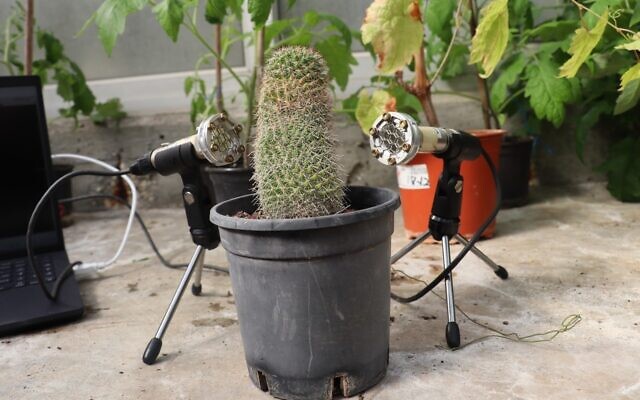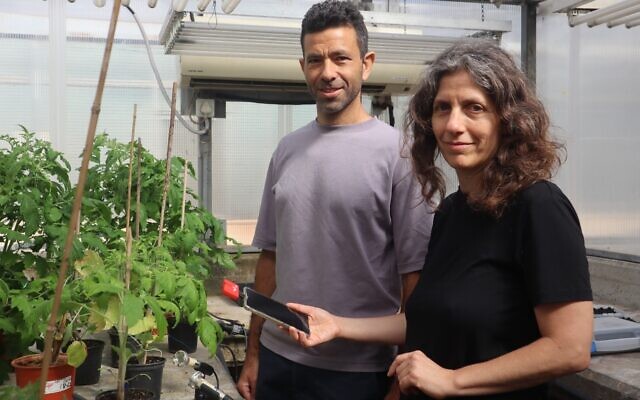In groundbreaking research, Tel Aviv U team records plants ‘talking’ for first time
Scientists discover clicking sounds, which humans can’t hear and which differ based on species and type of stress; wonder what uses other plants, animals make of the information
By SUE SURKES 30 March 2023

It has been known for some time that plants communicate with one another, but Israeli scientists now say they’ve identified “words,” and have found that different species speak in different “languages,” according to a groundbreaking new study published Thursday in the prestigious scientific journal Cell.
Scientists already know that plants communicate in a variety of ways when they are stressed. They might change physically (by wilting or changing leaf color), become bitter to the taste (to deter herbivores), or emit smells (volatile organic compounds) to tell other members of the family that they are under attack, for example by insects.
One recent study showed that plants can respond to sound by, for instance, increasing the sugar concentration in their nectar to lure pollinators that are making a ruckus nearby. d.
It turns out that plants “talk” in clicks, which sound a bit like popcorn popping. The sounds are emitted at a volume similar to human speech, but at high frequencies, beyond the hearing range of humans.
Prof. Lilach Hadany, from the university’s School of Plant Sciences and Food Security, who co-led the study, said, “We resolved a very old scientific controversy. We proved that plants do emit sounds!”
She went on, “Our findings suggest that the world around us is full of plant sounds and that these sounds contain information — for example about water scarcity or injury. We assume that in nature the sounds emitted by plants are detected by creatures nearby, such as bats, rodents, various insects, and possibly also other plants that can hear the high frequencies and derive relevant information.
“We believe that humans can also utilize this information, given the right tools — such as sensors that tell growers when plants need watering.
“Apparently, an idyllic field of flowers can be a rather noisy place. It’s just that we can’t hear the sounds.”
https://youtube.com/watch?v=hOWaXi0I2YE%3F
The research team recorded ultrasonic sounds emitted by tomato and tobacco plants that had been deprived of water, suffered a cut to the stem, or been left alone (as a control group).
Ultrasonic sounds have a frequency of 20 to 150 kHz, which is above the limit of human hearing.
The idea of testing at these frequencies emerged from a collaboration between Hadany, who comes from evolutionary sciences, and the other research co-leader, Prof. Yossi Yovel. Yovel, head of the School of Neuroscience and a faculty member at the School of Zoology and the Steinhardt Museum of Natural History, has been recording the sounds of bats, which also operate within this frequency range.
The plants were recorded both inside a silent acoustic chamber and in a noisy greenhouse. Physiological changes in the plants were also monitored.
Machine learning models were trained to match the sounds with different species of plants and the different stresses to which they were subjected.
“Our recordings indicated that the plants in our experiment emitted sounds at frequencies of 40 to 80 kilohertz,” said Hadany.

“Unstressed plants emitted less than one sound per hour, on average, while the stressed plants – both dehydrated and injured – emitted dozens of sounds every hour.”
The tomato plants, for example, made very little noise when watered, but in the subsequent four to five days, the number of sounds increased, then decreased, as the plants dried up.
Recordings were also made of sounds coming from tomato plants with tobacco mosaic virus.
To further test their findings, the team went on to carry out a small survey of additional plant species, successfully recording sounds from wheat, corn, Cabernet Sauvignon grapes, pincushion cacti, and henbit — the latter an annual plant from the mint family.

“We thus expect that many plants emit sounds, but the diversity of characteristics of these sounds is yet to be researched,” they write.
The researchers theorize that the sounds might be connected, partly at least, to cavitation in the stem. When a plant is under stress, air bubbles can form, expand and collapse in the xylem — the complex of tiny pipes that carry water and soluble materials from the roots to the stem and leaves.
Vibrations, as opposed to sounds, caused by this phenomenon, have been recorded by sensors in the past.
The scientists conclude that the findings could have potential for precision agriculture — for example for monitoring water and disease, particularly as climate change causes more drought, threatening ecosystems and food security.
They also hold out the tantalizing prospect that other organisms might be able to “hear” and react to the sounds.
“The plant emissions that we report, in the ultrasonic range of 20 to 100 kHz, could be detected from a distance of three to five meters (10 to 16 feet) by many mammals and insects, given their hearing sensitivity, for example, mice and moths,” the paper says.
“We have shown that plant sounds can be effectively classified by machine learning algorithms. We thus suggest that other organisms may have evolved to classify these sounds as well and respond to them.”
“These findings can alter the way we think about the plant kingdom, which has been considered to be almost silent until now,” the paper concludes.

Hadany and Yovel worked with research students Itzhak Khait and Ohad Lewin-Epstein, in collaboration with researchers from the Raymond and Beverly Sackler School of Mathematical Sciences, the Institute for Cereal Crops Research, and the Sagol School of Neuroscience – all at Tel Aviv University.
Speaking to The Times of Israel, Hadany said the sounds could simply be a side effect of physiological processes or could be a form of communication.
Scientists already know that one threatened plant’s emission of volatile organic compounds can help other plants to prepare for the danger that is being communicated.
Perhaps a plant’s sounds could have a similar effect, Hadany hypothesized, adding that sounds could be emitted more quickly than organic compounds.
“The sounds include information. We can learn about the plant’s state, so others can too. The question is who uses this information and for what.”
